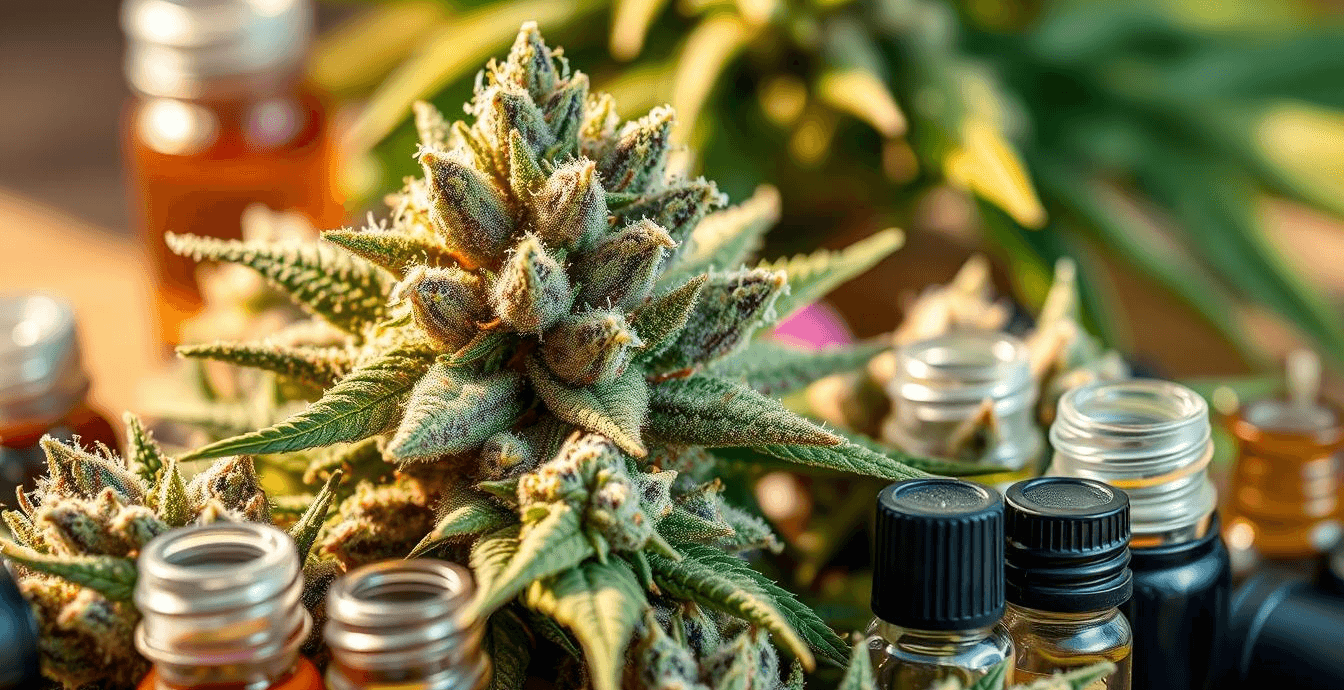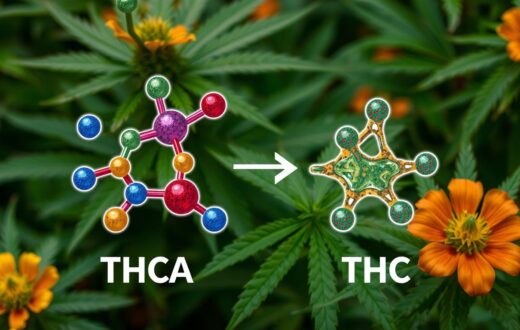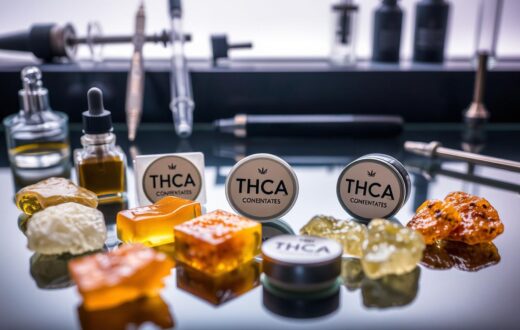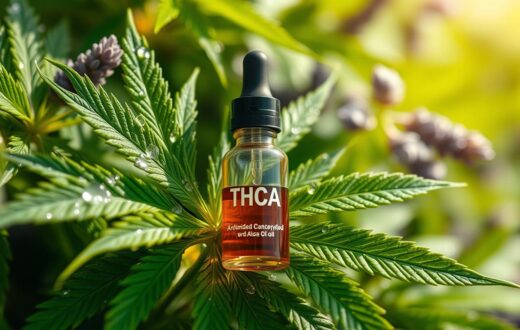Ever wondered why some cannabis strains make you feel energized while others melt you into the couch? The secret lies in the dance between cannabinoids and terpenes. This synergy, known as the entourage effect, is changing how we see cannabis and its benefits.
THCA, the non-psychoactive precursor to THC, is just one part of cannabis. While THCA flower has 10-15% total cannabinoids, the 2-5% terpene content is key. These molecules shape the effects we feel, not just our sense of smell.
Terpenes like myrcene calm us, while limonene uplifts. Together with THCA, they can boost therapeutic benefits. This means relief from discomfort and inflammation without THC’s high.
Exploring cannabis chemistry reveals exciting possibilities. For example, ocimene might fight fungi and slow tumor growth. Caryophyllene even talks to our body’s endocannabinoid system.
Understanding THCA and terpenes is key for relaxation, focus, or therapy. Let’s dive into cannabis science together. We’ll uncover how terpene profiles shape our cannabis experience.
Understanding THCA: The Basics
Cannabis chemistry is complex, with over 500 known cannabinoids. THCA is a key player, known for its unique properties. Let’s explore THCA and its relationship with THC.
What is THCA?
THCA, or tetrahydrocannabinolic acid, is a non-psychoactive cannabinoid found in raw cannabis. It’s the precursor to THC, the compound that causes the “high” from marijuana. THCA is present in fresh, unheated cannabis and doesn’t produce intoxicating effects on its own.
Differences Between THCA and THC
THCA and THC share the same molecular formula but have different chemical structures and effects. THCA doesn’t bind to CB1 and CB2 receptors in the brain, making it non-psychoactive. THC, however, interacts with these receptors, causing the well-known “high.” The conversion of THCA to THC happens through decarboxylation, triggered by heat, time, or light exposure.
Benefits of THCA
Research suggests THCA may offer therapeutic benefits without the intoxicating effects of THC. It’s believed to have anti-inflammatory, neuroprotective, and antiemetic properties. THCA might help manage conditions like arthritis and nausea. People seeking these benefits without the high often use THCA-rich products like raw cannabis juices or tinctures.
The Role of Terpenes in Cannabis
Terpenes are key in cannabis. They give each strain its unique smell and taste. Cannabis plants have over 200 known terpenes, with each strain having its own special mix.
What Are Terpenes?
Terpenes are natural chemicals found in many plants, including cannabis. They’re responsible for the distinct aromas we associate with different strains. In nature, terpenes help plants attract pollinators or ward off predators. In cannabis, they do much more.
How Terpenes Influence Aroma and Flavor
Terpenes shape the sensory experience of cannabis. Myrcene, found in hops and thyme, gives some strains a earthy scent. Limonene, common in citrus fruits, adds a zesty touch. Pinene brings a fresh pine aroma. These scents aren’t just for show – they can affect how we feel.
For example, lavender-scented linalool might promote relaxation. Cannabis analysis reveals that terpenes work with cannabinoids to create unique effects for each strain.
Synergy Between THCA and Terpenes
Cannabis research shows a cool connection between THCA and terpenes. These compounds team up to make cannabis’s effects special, known as the entourage effect. This teamwork makes cannabis more than just a mix of parts.
The Entourage Effect Explained
The entourage effect is when cannabinoids and terpenes work together. This boosts cannabis’s healing power. Studies show that THCA, THC’s non-psychoactive form, and terpenes create specific effects. This teamwork leads to better cannabis treatments for different needs.
THCA and Specific Terpene Interactions
Terpenes change how THCA affects us. For instance, limonene might make THCA’s mood-boosting effects stronger. Myrcene could make its relaxing effects more pronounced. These unique mixes lead to personalized cannabis treatments. Ongoing studies aim to learn more about these interactions, promising better medical cannabis use.
Common Terpenes Found in Cannabis
Cannabis contains many terpenes that make it special. Each strain’s terpene profile affects its smell, taste, and health benefits. Let’s look at some common terpenes in cannabis and what they do.
Myrcene: The Sedative Terpene
Myrcene is usually the most common terpene in cannabis. It has a strong earthy smell and helps you relax. It also makes your body absorb cannabinoids better. Many people use myrcene to feel calm and peaceful.
Limonene: The Uplifting Terpene
Limonene smells like citrus and makes you feel better. It has anti-inflammatory and antioxidant effects. Strains with lots of limonene can make you feel more awake and help with stress.
Pinene: Enhancing Focus and Memory
Pinene smells like pine and can improve focus and alertness. It also helps with breathing and has antibacterial properties. Some people say it makes their memory and thinking clearer.
Knowing about the terpene profile of different cannabis strains helps you choose better. With over 200 terpenes, each strain has its own mix. This mix affects how it smells, tastes, and works for health.
How Terpene Profiles Affect THCA
The world of cannabis chemistry is truly fascinating. It’s especially interesting when we explore how terpene profiles interact with THCA. Terpenes, the aromatic compounds in cannabis, are key in shaping the effects of THCA-rich products. Let’s look at how these tiny molecules can have a big impact.
Unique Effects of Different Terpene Combinations
Every cannabis strain has its own unique terpene profile. This creates a fingerprint of effects. For instance, THCA mixed with myrcene might lead to more relaxing effects. On the other hand, a limonene-rich profile could result in an uplifting experience.
This interaction between THCA and terpenes is what gives each strain its distinct character.
Balancing Therapeutic Effects with Terpene Profiles
Understanding terpene profiles is crucial for maximizing the therapeutic potential of THCA. Some terpenes may enhance THCA’s anti-inflammatory properties. Others could boost its pain-relieving effects.
By carefully selecting strains based on their terpene content, users can tailor their experience to their specific needs. This knowledge is especially valuable for those using cannabis for medicinal purposes.
The cannabis industry is increasingly focusing on terpene profiles in product development. From live rosin cartridges that preserve the fullest terpene profile to specific Delta 8 THC products enhanced with relaxing myrcene, there’s a growing emphasis on harnessing the power of these aromatic compounds. As research in cannabis chemistry continues, we’re likely to see even more innovative uses of terpenes in creating targeted, effective cannabis products.
Methods of Terpene Extraction
Terpene extraction is key in cannabis analysis and testing. It affects the quality and effectiveness of the final product. Let’s look at two common methods and why quality terpene sourcing is important.
Steam Distillation vs. CO2 Extraction
Steam distillation is a well-known method for extracting terpenes. It uses heat to separate terpenes from plant material. However, it can change heat-sensitive compounds.
CO2 extraction, a newer method, uses pressurized carbon dioxide. It keeps more terpenes and gives a purer product. Both methods are crucial in cannabis testing and analysis.
The Importance of Quality in Terpene Sourcing
Quality terpene sourcing is crucial for cannabis analysis. It impacts the product’s potency, flavor, and benefits. Proper extraction techniques keep terpene integrity.
This ensures accurate testing results. High-quality terpenes improve the cannabis experience. They work with cannabinoids like THCA in the entourage effect.
When looking for terpenes, choose reputable suppliers. They should use advanced extraction methods and strict quality control.
Terpene Preservation During Processing
In cannabis chemistry, keeping terpenes safe during processing is key. These volatile compounds can be lost easily due to heat, light, and oxygen. Traditional methods often result in a lot of terpene loss, affecting the quality and effectiveness of the final product.
How Processing Affects Terpene Content
Different extraction methods have different effects on terpene preservation. Hydrocarbon extraction is top for keeping terpenes, thanks to closed-loop systems. Ethanol extraction is harder because it needs to separate alcohol from the extract. CO2 extraction is popular but struggles to keep the natural terpene levels, even with supercritical methods.
Best Practices for Maintaining Terpene Integrity
To keep terpenes safe, cannabis processors use several methods. Flash-freezing fresh cannabis helps keep terpenes in. It’s also important to control temperature during extraction and processing. Some add terpenes back to products to improve them.
Using low-temperature extraction and storing in cool, dark places with little oxygen is crucial. These steps help keep terpenes in cannabis products.
Exploring Terpene-rich Strains
Cannabis strains vary widely, each with its own terpene profile. These compounds shape the effects and benefits of different strains. Let’s explore some popular strains known for their rich terpene content and high THCA levels.
Popular Strains High in THCA and Terpenes
Sour Diesel is a standout strain with a unique terpene profile. It’s known for its energizing and stress-relieving effects. Its high limonene content contributes to its mood-elevating and anxiety-reducing properties.
Blue Dream is another favorite, known for its balanced effects. It often contains myrcene, which adds to its relaxing properties.
Terpene Profiles of Notable Cannabis Strains
Each cannabis strain has its own terpene fingerprint. For example, some strains are rich in pinene, which may offer anti-inflammatory benefits. Others contain high levels of linalool, known for its calming effects.
The combination of these terpenes with THCA creates a unique experience for users. By understanding these profiles, consumers can choose strains that align with their desired outcomes, whether it’s relaxation, energy, or pain relief.
Remember, terpenes do more than just provide aroma. They interact with cannabinoids to enhance the overall effects of cannabis. This interaction, known as the entourage effect, underscores the importance of considering the full terpene profile when selecting a strain. Whether you’re seeking medical benefits or recreational enjoyment, knowing about terpenes can help you make informed choices about your cannabis consumption.
The Therapeutic Applications of THCA and Terpenes
Cannabis research is finding new uses for cannabinoids and terpenes. THCA, a non-intoxicating compound, has shown promise in many areas. When paired with terpenes, THCA might offer even more health benefits.
Anti-Inflammatory Benefits
THCA might help with inflammation. This could be good for arthritis or inflammatory bowel disease. Terpenes like beta-caryophyllene could make these effects stronger.
Anxiety and Stress Relief
Terpenes like linalool and limonene might help THCA reduce anxiety and stress. This mix could be a natural way to handle mood issues. Research is looking into how THCA and terpenes can help with chronic pain and neurodegenerative diseases.
Early studies suggest THCA is a strong antioxidant. Its anti-inflammatory properties make it a key area for future research. As we learn more, we might find new ways to use THCA and terpenes for better health.
Legal Considerations for THCA and Terpenes
The laws about THCA and terpenes in cannabis are complex and change from state to state in the U.S. The 2018 Farm Bill made hemp and its products legal at the federal level, as long as they have less than 0.3% Delta-9 THC. This opened the door for THCA products, but each state has its own rules.
THCA in the Context of Legal Cannabis
THCA hemp flower must follow strict THC limits to meet federal rules. Some states allow THCA products, while others don’t. For example, California, Florida, and Texas allow THCA, but Idaho and Louisiana don’t. It’s important for consumers to check local laws before buying THCA products to avoid legal trouble.
Regulations Surrounding Terpene Products
Terpene products have different rules based on their source and use. Some states require clear labels showing the amount of cannabinoids, like THCA and THC. There are also age limits, with many places requiring buyers to be at least 21. It’s key to get products tested by third-party labs to ensure they meet THC limits and are of good quality.
As the cannabis world grows, it’s vital to stay up-to-date on local laws. Choosing trustworthy sellers who are open about their products and testing is crucial. Knowing the laws about cannabinoids and terpenes helps consumers make smart choices and navigate the complex rules.
How to Incorporate Terpenes into Your Wellness Routine
Terpenes are important for making cannabis better. They help you make your wellness routine more personal. Let’s look at how to add terpenes to your routine and pick the best products.
Using Essential Oils with THCA
Essential oils with terpenes found in cannabis can improve your THCA use. For better focus, try oils with pinene like rosemary or eucalyptus. Citrus oils with limonene can lift your mood.
Mix these oils with THCA products for possibly better results. Start with a few drops in a diffuser or mix with a carrier oil for skin use.
Selecting Products for Optimal Effects
When picking cannabis products, look at their terpene profile. Strains like Jack Herer and Strawberry Cough have lots of pinene, helping with focus. For stress relief, choose limonene-rich strains like Super Lemon Haze.
GSC (formerly Girl Scout Cookies) has beta-caryophyllene, good for reducing inflammation. Try different mixes to find what works best for you.
The entourage effect shows terpenes and cannabinoids work together for better benefits. Start with small amounts and adjust as needed. By carefully adding terpenes, you can customize your cannabis experience for your wellness needs.
Research and Future Studies on THCA and Terpenes
Cannabis research is revealing new things about its complex compounds. Scientists have found over 545 different compounds in cannabis, including 125 cannabinoids. This discovery opens up exciting possibilities for future studies and uses.
Current Findings in Cannabis Research
Recent studies have shown that THCA, a non-psychoactive THC precursor, has potential. It may help protect the brain and reduce inflammation. Researchers are also looking into how THCA and terpenes work together. This could make treatments even better.
Potential Future Directions in Study
Future research will focus on understanding THCA and terpene interactions better. Scientists want to know how certain combinations can lead to better therapies. This could lead to new medicines based on these interactions.
The changing laws on cannabis are helping research grow. This change lets scientists study cannabis compounds like THCA and terpenes more fully. As we learn more, we’re finding new ways to use cannabis for health and wellness.
Consumer Education on THCA and Terpenes
Learning about THCA and terpenes is important for smart cannabis choices. With over 100 phytocannabinoids and 150 terpenes in marijuana, knowing your product is key.
Understanding Labels and Product Information
Product labels are full of important info for cannabis analysis. They tell you about THCA content, which turns into THC at about 87.7% potency. They also list terpene profiles, which affect smell and effects.
Some terpenes can make THC’s anti-inflammatory effects 20 times stronger than aspirin.
Importance of Expertise in Product Selection
Getting advice from experts is crucial when picking cannabis products. They can explain how cannabinoids and terpenes work together. This synergy boosts the benefits for health issues.
They can also help choose strains based on terpene composition. Terpene types vary widely across cannabis.
Staying informed about cannabis compounds is empowering. Keep up with testing methods and research. This knowledge helps you choose products that meet your needs, for health or fun.
Conclusion: The Future of THCA and Terpenes
As we finish our look at THCA and terpenes, it’s clear they have a lot of potential. Research keeps showing how THCA and terpenes work together. This could change how we use cannabis for health and fun.
Recap of Benefits and Synergy
THCA, the non-psychoactive part of THC, has many benefits. It can help with inflammation and protect the brain. When mixed with terpenes, these effects might get even stronger. This could make cannabis more effective for users.
The Importance of Continued Research
Learning about cannabis is just starting. We need more studies to understand THCA and terpenes fully. By studying different strains and terpene mixes, we’re getting closer to better cannabis treatments. This could bring new hope for health and happiness to many people.















